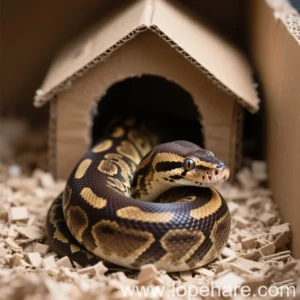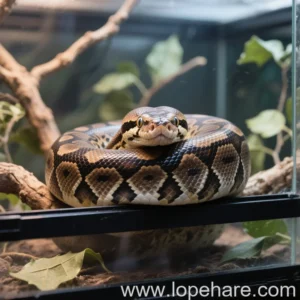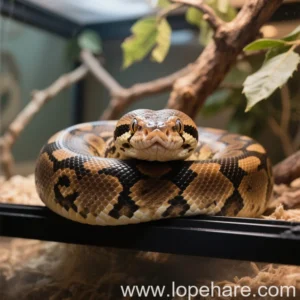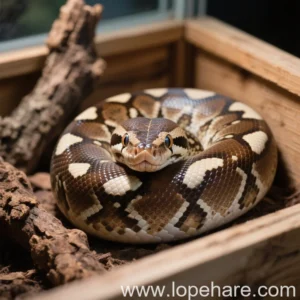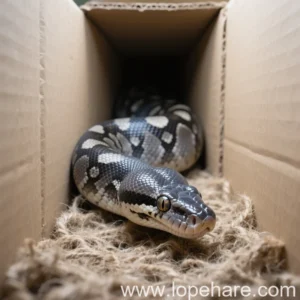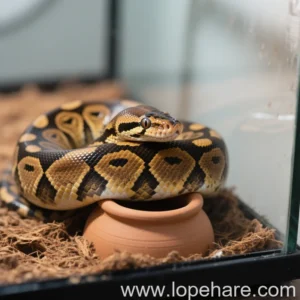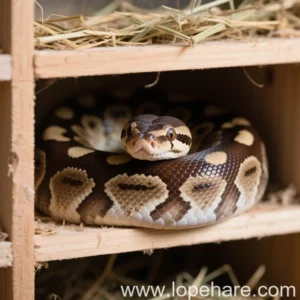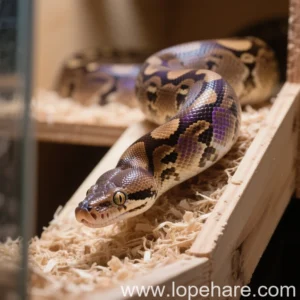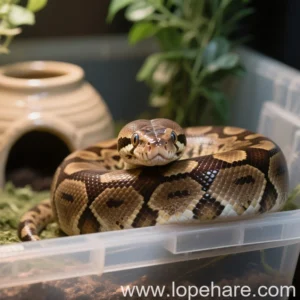Ball Python Egg Binding: Signs, Prevention, and Emergency Care
As editors at lopehare.com, we’re passionate about providing expert knowledge for specialized pet care. When it comes to breeding reptiles, particularly popular species like Ball Pythons, one of the most serious concerns is egg binding, also known as dystocia. This condition occurs when a female snake is unable to pass her eggs. It’s a potentially life-threatening emergency that requires prompt recognition and veterinary intervention. Understanding the signs, causes, and preventative measures is crucial for any Ball Python breeder or owner of a potentially gravid female.
What is Egg Binding (Dystocia)?
Egg binding (dystocia) in snakes is defined as the failure of a female reptile to lay her eggs normally. This can happen for various reasons, including issues with the eggs themselves, the snake’s physical condition, or environmental factors. Unlike mammals who give birth to live young, oviparous (egg-laying) reptiles like Ball Pythons must pass their eggs externally after they are fully formed within the body. If this process is interrupted, the eggs can become retained, leading to inflammation, infection, and potentially death if not treated.
Understanding the Cycle: Female Ball Pythons, even without mating, can produce infertile eggs (known as slugs). While these are often easier to pass, dystocia can still occur with both fertile and infertile clutches.
Recognizing the Signs
Identifying egg binding early is critical for a positive outcome. The signs can vary depending on the cause and how long the snake has been impacted, but here are common indicators:
Physical Signs
- Visible Swelling or Bulging: The most common sign is noticeable lumps or swelling in the lower half to two-thirds of the snake’s body, extending from mid-body towards the vent. These may feel firm.
- Prolonged Gravidity: The female remains gravid (carrying eggs) well past the expected laying date. For Ball Pythons, gestation is typically 45-60 days after ovulation. If she hasn’t laid by 70-80 days, it’s a concern.
- Straining or Pushing: The snake may exhibit behaviors indicating she is trying to pass eggs, such as arching her back, muscle contractions, or pressing her vent area against surfaces.
- Cloacal Swelling or Discharge: The area around the vent may appear swollen, red, or there might be a foul-smelling discharge if infection has set in.

A Ball Python showing slight ventral swelling, which could be a sign of egg binding or normal gravidity. Careful observation is key.
Behavioral Signs
- Lethargy: A significant decrease in activity levels.
- Loss of Appetite: Refusal to eat, which is expected during normal gravidity but prolonged refusal can indicate a problem.
- Restlessness or Agitation: Pacing the enclosure, constantly searching for a laying site, even if one is provided.
- Hiding Continuously: Secluding herself and not emerging, even during normal active periods.
- Unusual Posturing: Holding her body in strange positions or pressing it against substrates or decor.
Don’t Delay: If you suspect egg binding, do not attempt to force the eggs out yourself. This can cause severe internal injury. Contact a qualified reptile veterinarian immediately.
Causes and Risk Factors
Understanding why egg binding occurs can help prevent it. Causes are often multifactorial:
Environmental Factors
- Incorrect Temperatures: Temperatures outside the optimal range (typically a hot spot of 90-95°F (32-35°C) during the breeding/gravid cycle and ambient 78-80°F (25-27°C)) can disrupt the snake’s metabolism and muscle function needed for laying.
- Low Humidity: Insufficient humidity (Ball Pythons need 50-60% ambient, higher during shed and gravidity) can lead to dehydration, weakening the snake and potentially causing eggs to stick together or to the oviduct walls.
- Lack of a Suitable Laying Site: Failing to provide a humid, secure, and appropriately sized lay box is a major factor. Females need a place they feel safe to deposit their eggs.
- Stress: Poor husbandry, excessive handling of a gravid female, or an insecure environment can induce stress, inhibiting egg laying.
Nutritional Deficiencies
- Calcium Deficiency: Lack of adequate calcium and Vitamin D3 (needed to absorb calcium) is a primary cause, leading to weak muscular contractions necessary for passing eggs.
- Poor Overall Condition: An underweight or malnourished female may not have the energy reserves required for egg production and laying.
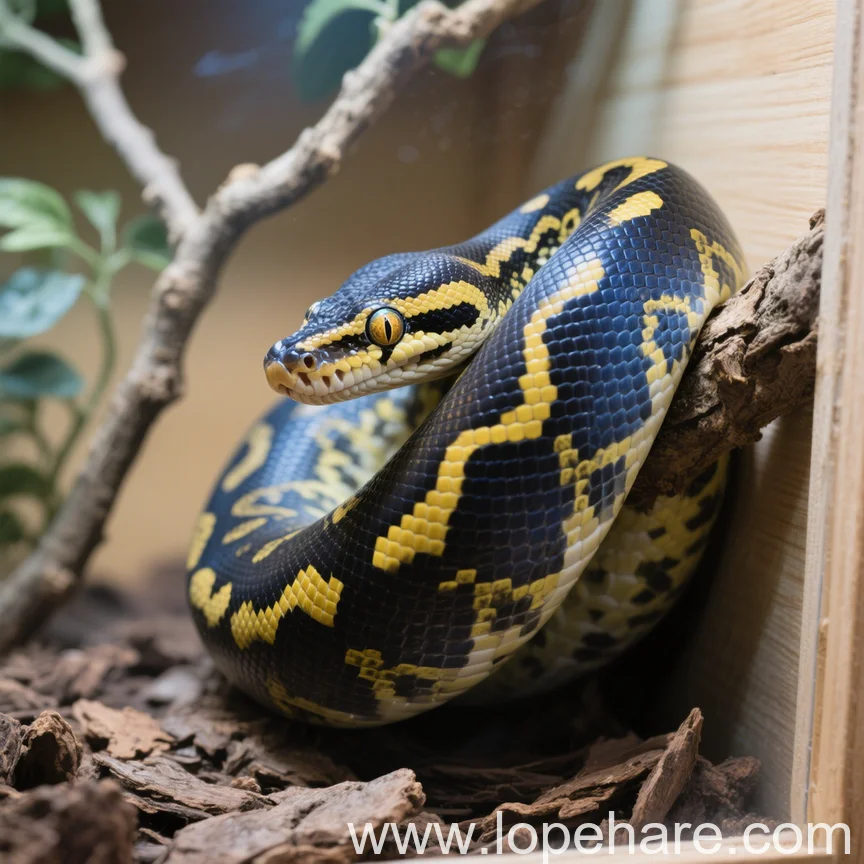
A healthy Ball Python in a proper enclosure. Maintaining correct temperature and humidity is paramount for preventing issues like egg binding.
Physical Issues
- Malformed or Oversized Eggs: Eggs that are too large, misshapen, or fused together can become physically stuck.
- Obesity: Excessive fat deposits can impede muscle function and obstruct the oviduct.
- Previous Injuries: Pelvic injuries, although less common in snakes than other animals, could potentially cause issues.
- Infection or Inflammation: Infections in the reproductive tract (salpingitis) or surrounding tissues can cause swelling and obstruction.
Breeding Inexperience
- Young or first-time mothers may be more susceptible due to inexperience or physiological immaturity.
Prevention is Key
Preventing egg binding is far better than treating it. Most cases are preventable through optimal husbandry and careful monitoring.
Optimal Husbandry
- Maintain precise temperature gradients, including a hot spot, cool side, and appropriate ambient temperatures year-round, especially during breeding season and gravidity.
- Provide consistent and adequate humidity levels. Utilize humid hides, misting systems, or appropriate substrates like coco fiber or sphagnum moss to help maintain humidity (aiming for 50-60% ambient, peaking higher during shedding and gravidity).
- Ensure excellent ventilation to prevent stagnant, overly humid air, which can lead to respiratory infections.
Proper Nutrition & Supplementation
- Feed high-quality, appropriately sized prey items throughout the snake’s life, ensuring she is in good body condition before breeding.
- Supplement breeding females with calcium, particularly during follicle development and gravidity. Use a calcium supplement without D3 most of the time, and one with D3 according to a vet-recommended schedule or if using UVB lighting. A reptile veterinarian can advise on the best supplementation plan.
- Ensure feeder insects, if used for younger or male snakes (though ball pythons primarily eat rodents), are gut-loaded.
Suitable Laying Site
- Provide a large, secure lay box filled with a suitable substrate like damp sphagnum moss or vermiculite. The box should be large enough for the snake to comfortably turn around inside.
- Place the lay box in the warmer section of the enclosure when signs of gravidity appear (post-ovulation).
- Ensure the substrate inside the lay box is kept appropriately moist, but not waterlogged.
Monitoring Gravid Females
- Keep track of feeding cessation, the “pre-lay shed” (typically 10-14 days before laying), and monitor for signs of nest searching.
- Record the date of ovulation (a noticeable mid-body swelling that lasts 24-48 hours) and the date of the pre-lay shed. This helps predict the expected laying window.
- Minimize handling of a gravid female to reduce stress.
Emergency Care: When to Seek Help
If you observe any of the signs of egg binding, particularly prolonged gravidity past the expected timeframe, visible straining without egg passage, or lethargy, it is an emergency. Seeking immediate veterinary care for a ball python with suspected egg binding is paramount. Do not wait, as the condition can rapidly deteriorate. Have the number of a local exotic reptile veterinarian readily available if you are breeding or own a mature female Ball Python.
Veterinary Diagnosis and Treatment
Upon arrival at the vet, the veterinarian will likely perform a physical examination. Diagnostic tests may include:
- Palpation: Gently feeling the snake’s abdomen to locate eggs.
- Radiographs (X-rays): This is the most common and effective way to confirm the presence and location of eggs and assess if any are broken or misshapen.
- Ultrasound: Can help assess the health of the eggs and the reproductive tract, and differentiate between eggs and other abdominal masses.
Treatment options depend on the severity and cause:
- Medical Management: If the snake is stable and eggs appear normal, the vet may attempt medical induction using hormones like oxytocin or arginine vasotocin to stimulate contractions, often combined with fluid therapy to combat dehydration and calcium supplementation. This is typically done under veterinary supervision.
- Manual Manipulation: In some cases, after medical induction and under sedation, a vet may attempt gentle external manipulation to guide eggs out. This is risky and should only be performed by an experienced professional.
- Surgical Intervention (Ova-salpingectomy): If medical and manual methods fail, or if eggs are broken, infected, or the snake’s condition is critical, surgery to remove the eggs and possibly the reproductive tract (similar to a spay) is necessary. This is a major procedure but can be life-saving. Survival rates for surgical correction of dystocia in snakes can be good if performed promptly, though like any surgery, risks exist.
Conclusion
Egg binding is a serious, but often preventable, condition in female Ball Pythons. By providing impeccable husbandry – correct temperatures, humidity, nutrition, and a proper laying site – you significantly reduce the risk. Knowing the signs and being prepared to seek immediate veterinary attention are vital components of responsible breeding and ownership. At lopehare.com, we stress that proactive care and education are your best tools for ensuring the health and well-being of your specialized pets, including your beloved Ball Pythons. Stay vigilant, provide the best possible environment, and consult with reptile experts when needed.
For more information on general Ball Python care and preventing common health issues, explore other resources on our site.
References
- Wikipedia: Egg Binding
- Journal of Herpetological Medicine and Surgery – Articles on reptile dystocia (Specific article examples vary, general topic reference)
- Various veterinary textbooks on reptile medicine.
